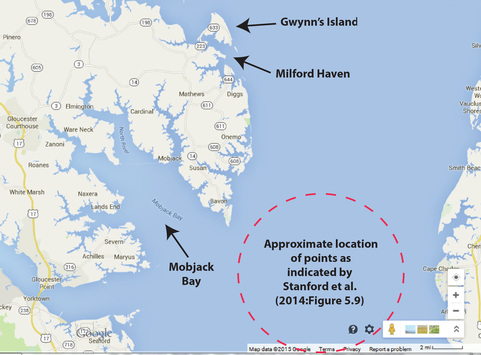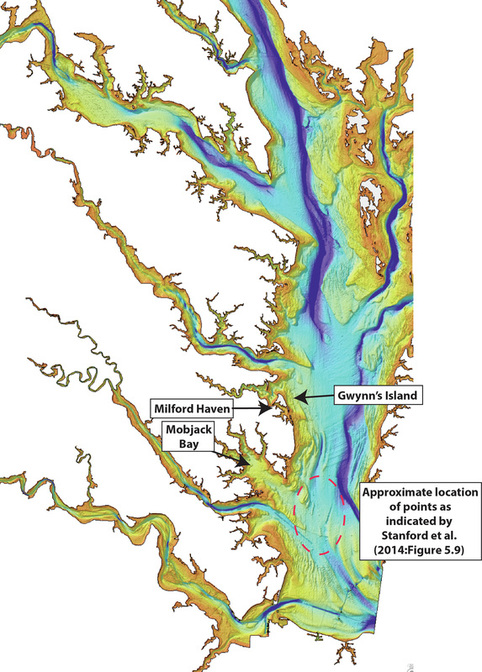"For sale--the only Solutrean-American continental bi-faces (2) available for sale in the world. Dating to approx 23,000BC, these blades were recovered from the bottom of the Chesapeake Bay by scallop dredge.
Offered now for $20,000--the price will only go up as more evidence mounts.
My friend, the late Mark Small obtained these by trade and it wasn't until after his passing 8 years ago that we learned what these were. I talked the widow into showing the collection at the Gwynn's Island Museum a few years ago. Dr Stanford and his team from the Smithsonian were there to present a casting of the Cin-Mar blade to the folks who donated the original to the Smithsonian.
Upon seeing these, a request was made to loan them to the Smithsonian, which was done. The results are that the Solutrean Hypothesis rests upon these and other blades like them found in recent years on shore and off on the continental shelf--and they were made by peoples coming from France at the height of the ice age."
That post (dated September 25, 2014), was followed up by another (May 6, 2015) that gives more details of how the points came to be included in Stanford's Solutrean work:
"The [M]ark Small examples were discovered by Dr Stanford and his team at the Gwynn's Island Museum during his annual visit to ID and examine others' collections. I induced Mark's widow to bring the collection, then held by her son for safe keeping. The collection showed up, under his care, as piles of arrowheads laid upon sheets of foam, one atop the other. Her son had rifled every case open....but that's another story. Amidst the mess, Dr Stanford grasped the significance of these two pieces, his then fiance marveling over the smaller examples' evident resharpening trajectory, and the colors of the material isteld--both pieces are rhyolite. Casts made by Michael Frank were used at the Paleo conference in 2012, where thousands of archaeologists examined their displays. These are considered significant to the evidence supporting the Solutrean Hypothesis, and they reside in my hands for now--anyone wishing to examine them need but make arrangements with me to come here."
The sale of the purported Solutrean artifacts is apparently being handled by Trimble's Tavern Antiques in White Stone, Virginia. David Stone Sweet is listed as the contact person, and I'm guessing he's the one responsible for the Facebook postings and the posts (by "Stone") about the points on this forum.
The points being offered for sale are shown as (a) and (e) in Figure 5.10 of Stanford et al. (2014:90; available here and here). The discussion of the points in that paper is limited to the following:
"A large knife (Fig. 5.10a) made of quartzite was dredged from the bottom of Mopjack Bay near Norfolk, Virginia. Use-wear studies suggest that it was not hafted, but rather it was hand-held. A heavily resharpened biface (Fig. 5.10e), was also dredged from Mopjack Bay. Like the Cinmar biface, this tool was made of banded rhyolite and was used as a hafted knife." (Stanford et al. 2014:90).
The "Mark Small's Artifacts" page on Facebook also has the points for sale. The price is the same, but the provenience story is a little different:
"The Pair for $20,000 These are possibly the only known American Solutrean blades offered for sale in the world!
These are the real-deal, rare as hen's teeth and the identification of these is without question--note these two blades in the case of points directly under Dr's Stanford and Bradley's hands in the third pic. Dredged from the Chesapeake Bay near Haven Bar Bouy and the ancient Paleo-channel that outlets there from Milford Haven.
The bay is at it's deepest, 150ft--the deepest bay in the world.
Shown in Dr Stanford's Exhibit at the conference are these two blades along with detailed pen and ink sketches showing flaking patterns, and a map showing approximate find locations."
The story posted by "Stone" on this forum has a bit more detail:
"Mark Small found several on [Gwynn's Island] off that point, and Pleistocene fossils turn up on that stretch of now swiftly disappearing sand. leeward of that island is Milford Haven, an ancient drainage of the Piankatank and Queens Creek systems that carved a channel to some 6 miles out during times when the lands were dry. That paleo-channel reaches to the old banks of the Susquehanna River, then at some places only a mile wide and some less. The two blades in my hands now came from below the edge of the banks of that channel--they were recovered by scallop dredge."

 Locations relevant to the provenience of the "Mopjack laurel leaf" points indicated on bathymetric map of Chesapeake Bay. Bathymetry data source: http://www.virginiaplaces.org/chesbay/chesgeo.html
Locations relevant to the provenience of the "Mopjack laurel leaf" points indicated on bathymetric map of Chesapeake Bay. Bathymetry data source: http://www.virginiaplaces.org/chesbay/chesgeo.html If the information provided by the seller of the points is accurate, Mark Small (deceased at the time the points were shown to Stanford) did not find the points himself but got them through trade. I haven't located any other details about who originally found the points or how we know anything about where and when the points were found (other than "scallop dredge"). We are told that the collection containing the points was taken to the Gywnn's Island Museum specifically so that Stanford could look at it, and the seller's description makes it clear that Stanford's endorsement of the points in the collection is an important part of the story now attached to them. Stanford's interpretation and publication of the points as authentic New World Solutrean artifacts appears to be the sole criterion for attaching an extraordinary monetary value to them.
So what's the Solutrean hypothesis worth? To people invested in the monetary value of authentic "Solutrean" artifacts from eastern North America, quite a bit. To the rest of us . . . you'll have to decide that for yourself.
Also: Chesapeake Bay is not the deepest bay in the world. That honor goes to the Bay of Bengal, which just squeaks out a win over Chesapeake Bay's 150' with a maximum depth of 3 miles. Pesky details.
Stanford, Dennis, Darrin Lowery, Margaret Jodry, Bruce A. Bradley, Marvin Kay, Thomas W. Stafford and Robert J. Speakman. 2014. New Evidence for a Possible Paleolithic Occupation of the Eastern North American Continental Shelf at the Last Glacial Maximum. In Prehistoric Archaeology on the Continental Shelf, edited by Amanda Evans, Joe Flatman, and Nicholas Flemming, pp. 73-93. New York: Springer-Verlag.


 RSS Feed
RSS Feed
